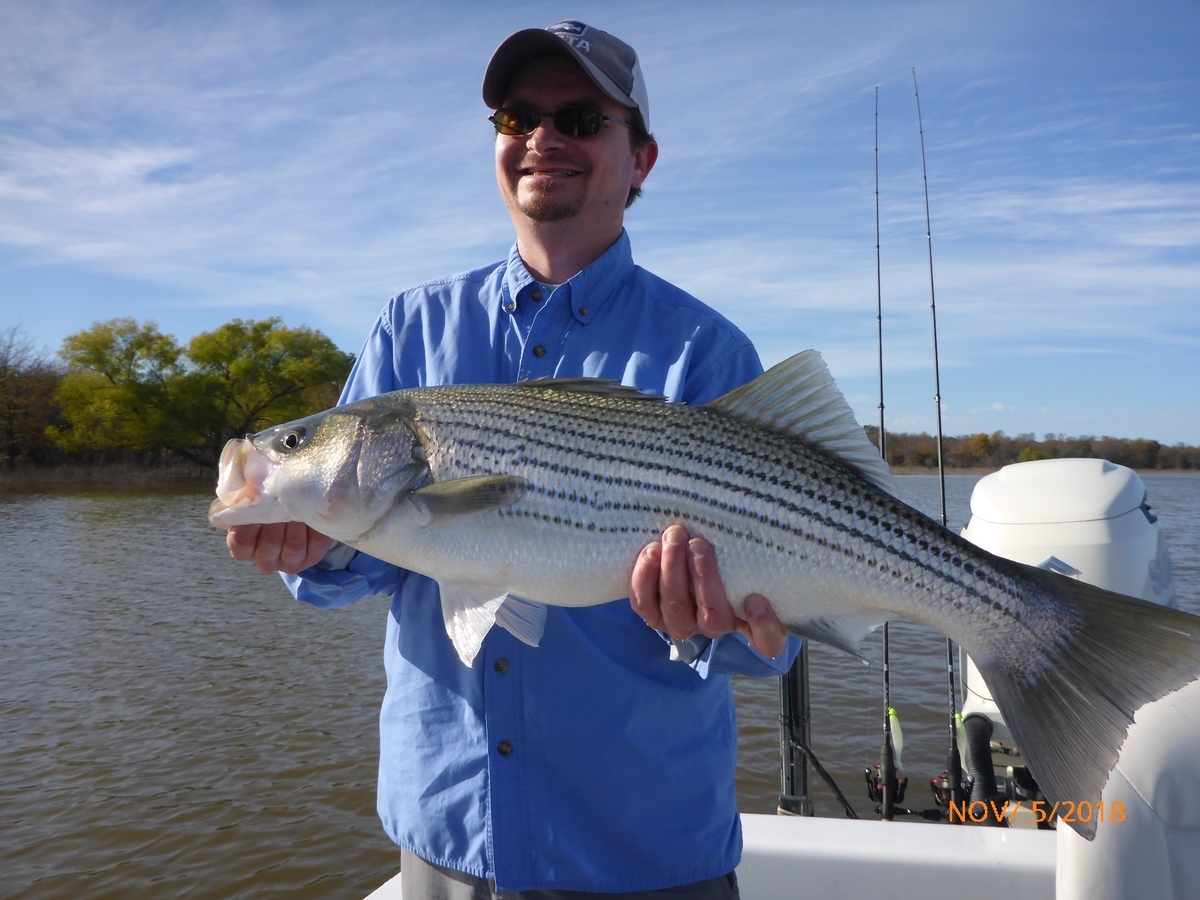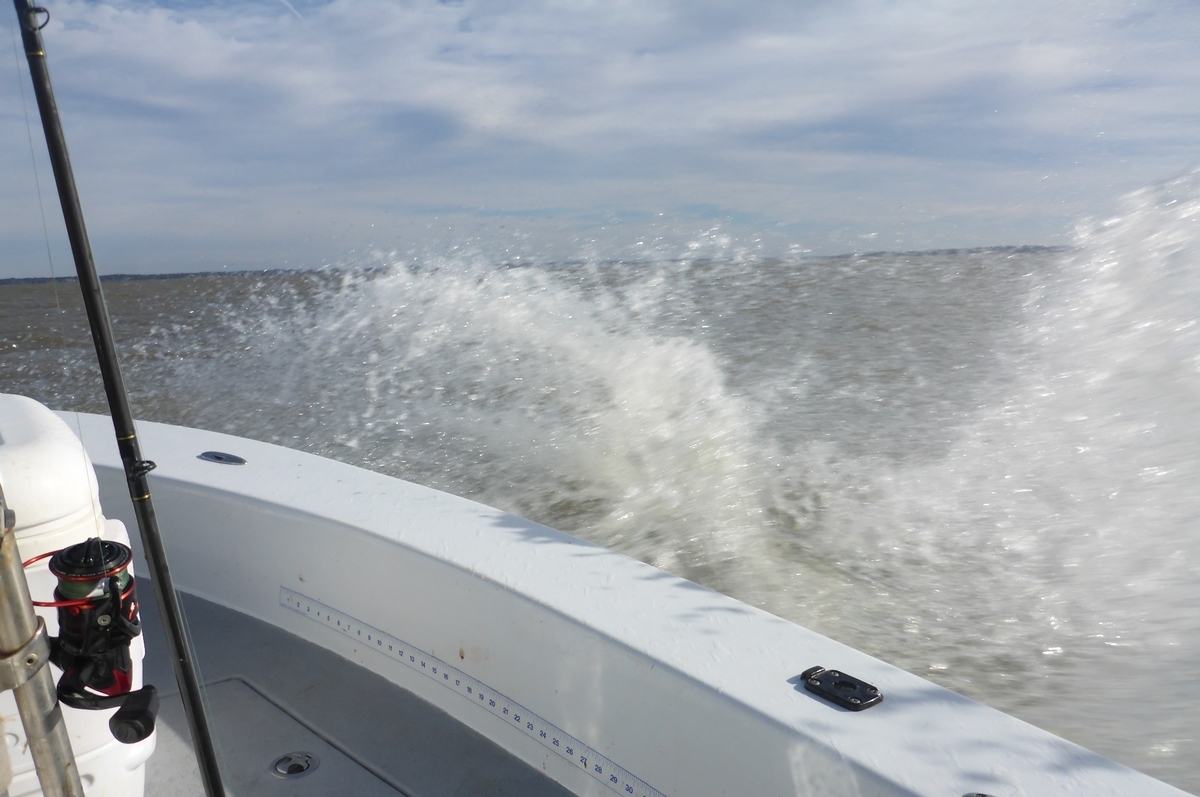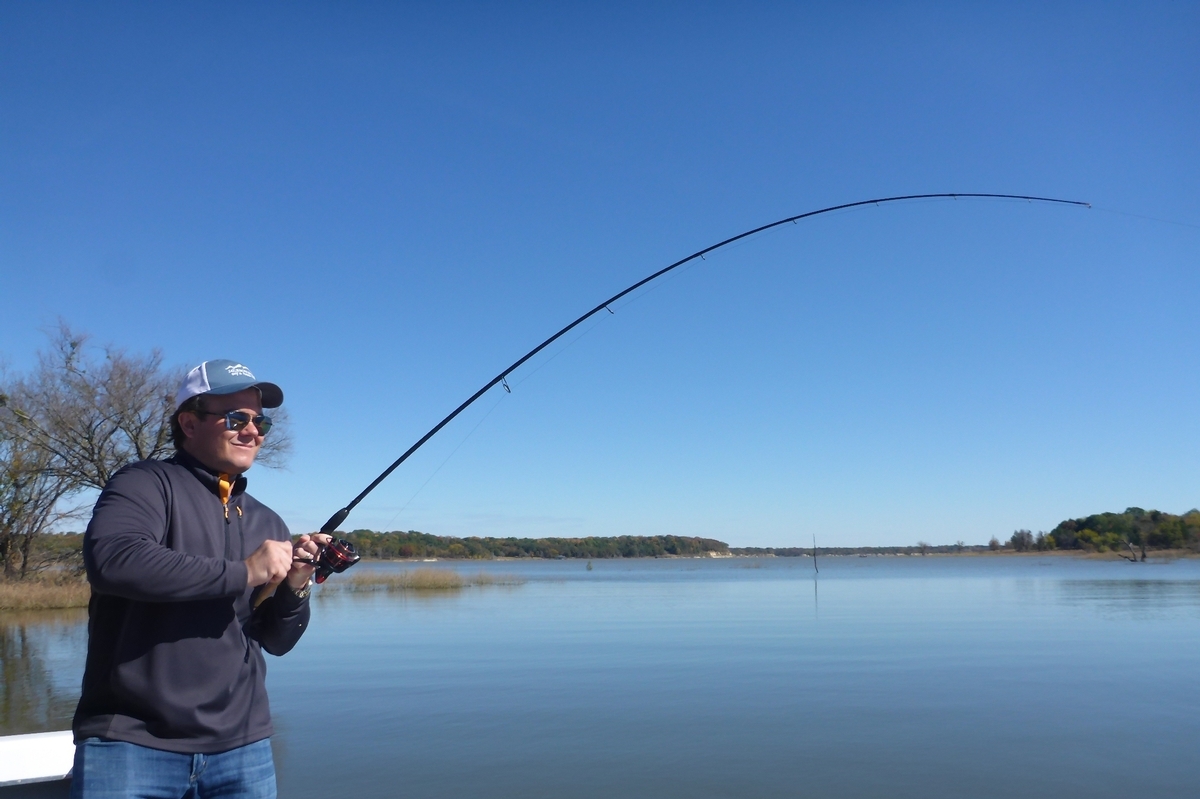
November 12, 2018 by Capt. Stephen Andre'
How will the fishing be today? Will the Striper be in the same place as yesterday? Are they going to be hitting the same lures?... these are just a few of the thoughts that run through my head on the day of a Striper trip on Lake Texoma. Most of you probably think my fishing trips begin at 5am each day for me, but each days Lake Texoma Striper Trip on actually begins the day before. At the end of your fishing trip with me, my day is far from over. I like to be prepared, and plan ahead…. that’s just who I am. The day before a Striper trip there are numerous actions I will take in preparation for the day ahead. This helps me relax and reduce my nervous anticipation on the morning of the fishing trip. And yes, I still get nervous, especially if the trip is with someone I have not fished before. I have no idea what their expectations are for the day! I take my job very seriously and want to impress my clients; it’s good for business, good for them and good for me. So what exactly am I up to when you all are not around my boat dock?
Once I get my cleaning table and dock all cleaned up from cleaning fish, I will begin getting ready for the next day’s fishing trip. This includes numerous items, and I do these every day. I clean my cooler. I can not imagine throwing a beautiful Lake Texoma Striped Bass into a dirty, smelly cooler. And trust me I have seen some nasty ones on other guide boats. I’ll rinse the cooler very well with fresh water and scrub every day and I do a deep clean with Purple Power cleaner every 3rd trip. I would eat soup from my cooler each day after it is clean, that’s how clean I keep it. I don’t use bleach or pine sol, they are bad for the environment and there is no reason to put that stuff into any lake. Same with the boat, Purple Power cleaner, and I deep clean the boat once a week. If we gut hook fish and the boat is bloody, I’ll rinse and scrub with fresh water every trip if necessary. Yes, it takes a lot of time, but I get numerous compliments weekly on how clean my boat always is, and those compliments alone are worth all the extra effort. If you do cleaning maintenance, you will never have to take a full day to clean it right. When I’m done cleaning, time to fuel up. I always have at least ¾ tank of fuel when I stroll down to my boat in the mornings. I have never run out of fuel. There is just no excuse for that!

The importance of fresh knots is a high priority. Retie and retie often. What a bummer when you set the hook on a fish of a lifetime and only to come back with a broken knot or one that has come untied! I use a Palomar knot for braid, a clinch knot for monofilament and a blood knot for joining braid to a mono leader. I retie all my lure knots the day before each trip. And retie during the trip if we are really getting them. I always use braid with a leader. I have done that for years. The braid lasts a long time, backlashes are easy to pick out of baitcasters and the braid works great on the spinning reels. 30-pound Power Pro with a 20 lb. leader. If my leader has been retied a bunch and gets down to 2 feet or less, I’ll tie on a new 5 to 6-foot leader. I will inspect swimbaits while retying and if they are torn bad I will replace them. If they still have a few catches left in them, I will use some super glue and glue it back to the jig head. I do this all the time and it saves me some money on swimbait tails in the long run, and the Lake Texoma Striper do not care!
I will typically have 15 rods on board each trip. I can have up to 6 clients on board. That’s 7 spinning rods, and 8 baitcaster rods. Sometimes I do not know the level of my clients fishing skills, so I need to be prepared. This number of rods allows me to keep different lures tied on (usually a slab, topwater, and swimbait) and it allows me to hand a client a fresh rod, ready to go if there is a backlash, broken line, or reel issue. This keeps them fishing, and not waiting for me to fix a problem. I need to be prepared to teach clients how to cast. I can teach anyone how to cast a spinning reel. I do not drop live bait and wait. I do not troll. We fish. We cast. We slab. We move from point to point from cove to cove. I find the actively feeding Lake Texoma Striper and teach you how to catch them. All knots are retied, lures are freshened up, and reels are casted and tested and ready for the next day. What’s next?
When was the last time you checked your oil on your motor? What about the water level in your trolling motor batteries? How about the connections on your batteries? Well, for me, it is often. I am not out fishing with some buddies and playing around on Lake Texoma. My boat is my office, my transportation. My workhorse, and my and your lifeline back to safety if need be. You all pay good money for me to put you all on some good Lake Texoma Striper. The last thing I want is something as simple as low oil or a dead battery to cut into your fishing time. I check my oil once a week and battery water level once a month. It does not take hardly any time and gives me piece of mind. Of course, I do my standard maintenance as well per the manufacturer’s maintenance schedule. Fuel filters, spark plugs, valves, etc., and I keep meticulous records for my benefit. My boat reliability is not something I can cut corners on. It is my living. If something is broke, I fix it. If something might break, I fix it. If it cost a little more to last a little longer before it might break, I’ll buy it. That boat is another child in my family, and I care for it as such.

As a guide, I must watch the weather although there is nothing I can do to control it. First and foremost is safety. If there is lightning, we are not going anywhere. I have been on the water when the rods are buzzing, and lightning has hit the water a mile from the boat. No thanks. If it is raining, we will usually go. Now that being said, there are countless variables that will play into the go-no-go factor. Secondly, are we going to enjoy the trip? I do this for a living and if I do not want to go, then you must listen to your guide. Yes, we all have time invested and money, but we should have fun. If there are kids and it’s going to pour rain all day, we probably will reschedule, especially if it is cold as well. If I have 4 burly guys that are dressed right and have enough whiskey to keep them warm for 5 hours, then we are going! It is a judgement call on my part with tons of variables involved. I want everyone to be safe, have fun, and catch fish. Occasionally the weather will not let that happen. It is what it is, and rescheduling is the best alternative at times. It is your Striper trip and I want it to be a good memory!
Its summer, the early morning topwater bite has been fantastic…and we cannot be late… I sit and wait for my clients. They pull into the parking lot just on time…and then…and then...they talk, they go to the bathroom, they do this and that and all I want is for them to get on the boat on time, so we don’t miss out on the awesome early topwater bite!!! COME ON!!
It happens! And, oh well nothing I can do! It has been months in planning, and here come my clients down the dock. The boat is ready, the gear is ready, I am ready, are they ready? Well, most of the time they are. I send out an email weeks prior to the trip to let my clients know exactly what they need and what to expect and when we should leave the dock. But occasionally they will show up late, underdressed or with no license. I address these issues before we leave the dock. We must have a Texoma Fishing License before we leave the dock. They need to be warm before we leave the dock. It is just that way. It is their trip and I need to accommodate to their needs. All the outside factors that I cannot control are what they are, but It can stress me out sometimes before we even get out of the boat dock! This is their trip, their one time a year or maybe even 3 years they can get on the water. I get spoiled being out there every day. I must remember this is their special day. Their big trip. They have been looking forward to this for a long time. I must keep my cool and fish on! Now we head on out and anticipation is at all a time high!

As we cruise across the lake, cool wind in our hair, checking out the early morning twilight, my brain is racing! Will the fish be where I caught them good yesterday? Are there going to be a ton of boats already there? We pull into our first spot, I am ready to cast and see if they are here. But, I need to address my clients and make sure they are good to go with a spinning reel or a baitcaster. Do they need a refresher on how to cast? I always make sure they cast first. I wait and watch and make sure they are good. I want to cast and catch, but I really like them to catch the first Striper! If all goes well, I may never get to fish until later in the trip. That’s fine with me, because that means I am netting fish and they are catching. That sound of “got one” from my clients is always music to my ears.
As we fish, I am always thinking about my next move. I need to be going through my options in case the fishing pattern has changed overnight, and sometimes it will change. It may even change several times throughout one trip. I may need to change my tactics based on my client’s skill level. If they can cast decent, but it’s blowing 30 mph and making life difficult, I’ll have to adapt. Maybe change locations out of the wind but will there be fish in that situation. Or may have to change over to slabs, where is the deep bite for that? Every trip will be different due to client’s skills, weather, boat traffic or other reasons. This is where experience with clients, and time on the water comes into play. Knowing how to read clients is a challenge. Are they having a good time? What can I do for these clients to make sure they have their best trip ever? Some are happy with catching a bunch of 16-inch fish and filling cooler. Others may want only big fish and keep only a few to eat. The dynamic for each trip changes from client to client and day to day.
When the pattern does change, or fish have moved locations, this is when time on the water and networking comes in a can save the day. If my spots from the day before are not producing, then it’s time to go looking. I will search areas from 2 trips ago or last week or go looking in areas they should be based on the time of year, water temperature, water color or water depth. I will contact other artificial lure only guides that fish year around with artificial lures like I do. We are a small tight knit group and share information to each other to help one another out. We are all out there to catch fish and networking helps. Only a few of us use artificial lures all year. We are a specialty and fish differently than the other 95% of the guides on the lake that use live bait or troll. At the end of the day I will do whatever it takes to make sure everyone on the boat catches Striper. I will change tactics, locations, call other guides, or drive all over the lake to make it happen. That’s what my clients are paying me to do.
Now, there are some days when Lake Texoma Striper simply will not cooperate! I will usually know in the first 2 hours of a trip if we are going to have a successful outing or not. This will typically happen if the water is freezing cold, below 42 degrees, or burning hot, above 88 degrees. Striper hate those extremes. It is at that time I have a decision to make. Am I going to continue to burn gas and look and hope (after I have already done that) or will I swallow my pride and miss out on a paycheck and have them come back another day. As stated before, there are many variables that go into that kind of a decision. I want them to have a successful memorable trip and come back for future trips. So, when this happens, we have a “meeting” on the boat and make a decision based on what is best for the client.
Running back to the boat house, cooler is full, rods are put away, successful Lake Texoma Striper Fishing trip, what a feeling! I put great pressure on myself as a professional full time Lake Texoma Fishing Guide to get a respectable limit of Lake Texoma Striper in the cooler. This does not always happen. 9 times out of 10 my clients understand that it is not always going to happen. Most are fishermen, and most understand that despite all my efforts, fish are fish and they will do what they want including sitting in the water with their mouths closed!
Once we are at the dock, now comes that special time when they see all of what we have caught. It still amazes me how shocked they are when they open the cooler and see what they have accomplished. I take my time to lay out all the Striper on the cleaning table for the group picture. This is the picture they will post on FB and show all their friends. This is the “trophy” at the end of each Texoma Striper trip. I make sure they are all smiling, and all the Striper are in the picture. I make darn sure all the kids are right there in the middle of it, because for them this is an epic moment in their memory. How do you clean your Striper? Do you get all the red meat out? Well, I do…I clean each and every one of their fish as if I was cleaning them for my family to eat. No bones, no red meat, no fins. There is no excuse to not take the time and do it right when it comes to properly cleaning a Striped Bass. It’s not rocket science, it does take time, and not all guides will do it right for you. When I hand them their bag of fillets I make sure they know they are cleaned and READY TO EAT! I have Striper recipe cards I give out to each of them as well. Something a little extra, cuz that’s the way I roll.
I often get asked if I get tired of fishing. I must admit it is a lot of work and can be stressful at times. My answer to them…” I do get tired, but I never get tired of fishing!”
Capt. Stephen
Posted in: News, Lake Texoma, Striped Bass Tips and Tricks

2026 Photos & Text Copyright - © Lake Texoma Striper Hunter Guide Service
Fishing Guide Websites by 3plains
